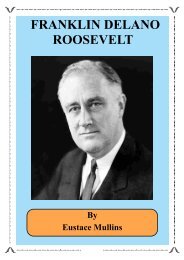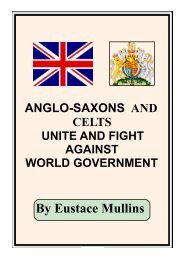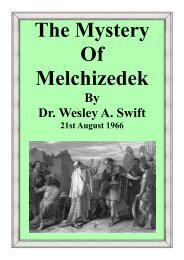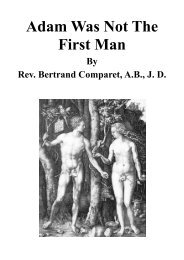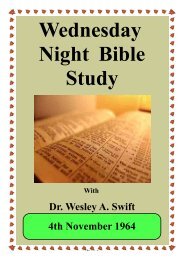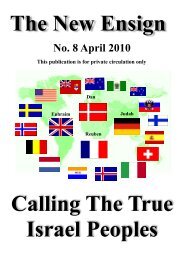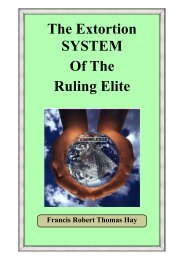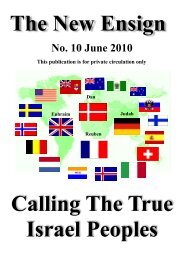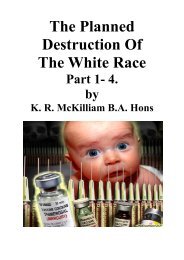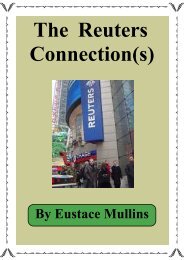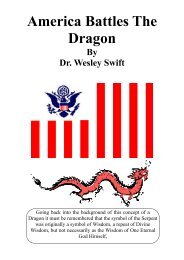Curse of Cannan - The New Ensign
Curse of Cannan - The New Ensign
Curse of Cannan - The New Ensign
You also want an ePaper? Increase the reach of your titles
YUMPU automatically turns print PDFs into web optimized ePapers that Google loves.
Sumter. Another member <strong>of</strong> the Charleston Lodge, James Moultrie, was the principal figure<br />
behind the Nullification Crisis in South Carolina during the 1820's and 1830’s. He was named<br />
Grand Secretary General <strong>of</strong> the Scottish Rite for all <strong>of</strong> the Southern states.<br />
During the nineteenth century, Masonic agitators travelled about the world, inflaming the<br />
populaces with passionate cries for "liberation," and "the Rights <strong>of</strong> Man." Unfortunately for those<br />
who were deceived by these manipulations, the only rights they were pursuing were the rights<br />
<strong>of</strong> Masonic Canaanites to battle and exterminate the people <strong>of</strong> Shem. Every other consideration<br />
was subordinated to this primary goal. As a result, every nation which was lured into the "Rights<br />
<strong>of</strong> Man" trap became an absolute dictatorship whose <strong>of</strong>ficials used their powers to destroy the<br />
people <strong>of</strong> Shem, their demonic goal, and part <strong>of</strong> their Satanic rebellion against God. As Grand<br />
Master, Lafayette directed the Juarez revolution in Mexico; in South America, Bernardo<br />
O'Higgins and Simon Bolivar, both <strong>of</strong> whom were Masons, led the revolutionary forces against<br />
Spain in country after country. Since the Spanish governments in these countries were also<br />
Catholic, these revolutions proved to be an integral part <strong>of</strong> Masonry's openly declared war against<br />
the Catholic Church.<br />
In Italy, Mazzini and Garibaldi led the atheistic revolutionary forces which culminated in the<br />
arrest <strong>of</strong> the Pope and the establishment <strong>of</strong> "unification" in Italy in 1860. From the outset, this<br />
Masonic uprising was planned and financed by British Secret Intelligence Service, and directed<br />
by Lord Palmerston, Foreign Minister <strong>of</strong> the British Empire. When Louis Kossuth, the Hungarian<br />
revolutionary, visited the United States, Masonic organizations throughout the country planned<br />
large scale demonstrations and victory banquets for him. It is doubtful that any visitor to these<br />
shores has previously or since been lionized to the extent that Louis Kossuth was received. Even<br />
today, there are still many buildings and avenues in American towns throughout the country<br />
which are named after Kossuth, memorializing this leader <strong>of</strong> Freemasonry.<br />
In 1845, Mazzini originated the Young America movement in the United States. Although<br />
primarily active in rural areas as a farmer's movement, it was directed by Mazzini to play an<br />
active role in the growing abolitionist movement, which he also directed. His friend, William<br />
Lloyd Garrison, who later wrote the Introduction to Mazzini's authorized biography, became the<br />
most inflammatory <strong>of</strong> the abolitionist propagandists. He called his newspaper "<strong>The</strong> Liberator."<br />
Garrison started this paper in 1831. From the outset, it was liberally financed by unnamed backers,<br />
who saw to it that free subscriptions to "the Liberator" were distributed throughout the Southern<br />
states. <strong>The</strong> State <strong>of</strong> Georgia was moved to <strong>of</strong>fer $500 reward for Garrison's arrest or for the<br />
detention <strong>of</strong> any member <strong>of</strong> his American Anti-Slavery Society. Garrison frequently went to<br />
London for conferences with Mazzini on the strategy <strong>of</strong> the abolitionist movement. <strong>The</strong>y usually<br />
met at the <strong>of</strong>fices <strong>of</strong> the well-known London solicitor, William Ashurst. Few Southerners have<br />
ever heard the name <strong>of</strong> Mazzini, and even fewer know that this fiery Masonic revolutionary was<br />
the actual instigator <strong>of</strong> the Civil War. He is privately known among the cognoscenti (or Gnostics)<br />
as the godfather <strong>of</strong> the anti-slavery campaign in the United States.<br />
This abolitionist propaganda caused widespread resentment throughout the South. On December<br />
16, 1835, the State <strong>of</strong> South Carolina issued a formal resolution on the matter: "Resolved, that<br />
the formation <strong>of</strong> the abolitionist societies and the acts and doings <strong>of</strong> certain fanatics calling<br />
themselves abolitionists in the non-slave holding states <strong>of</strong> this confederacy, are in direct violation<br />
<strong>of</strong> the obligations <strong>of</strong> the compact <strong>of</strong> the union, dissocial, and incendiary in the extreme."<br />
Note that in 1835, South Carolina used the term common until after the outcome <strong>of</strong> the Civil<br />
War, a confederacy <strong>of</strong> states associated under the provisions <strong>of</strong> a compact, the Constitution <strong>of</strong><br />
the United States. <strong>The</strong> abolitionist propaganda did constitute a direct invasion <strong>of</strong> the Southern<br />
States and as such was an undeclared state <strong>of</strong> war; it was also, as the South Carolina Resolution<br />
pointed out, a direct violation <strong>of</strong> the terms <strong>of</strong> the compact. Nevertheless, this invasion by<br />
propaganda continued, until it was at last followed by the direct military invasion <strong>of</strong> the Civil<br />
War.<br />
( Page 74)



